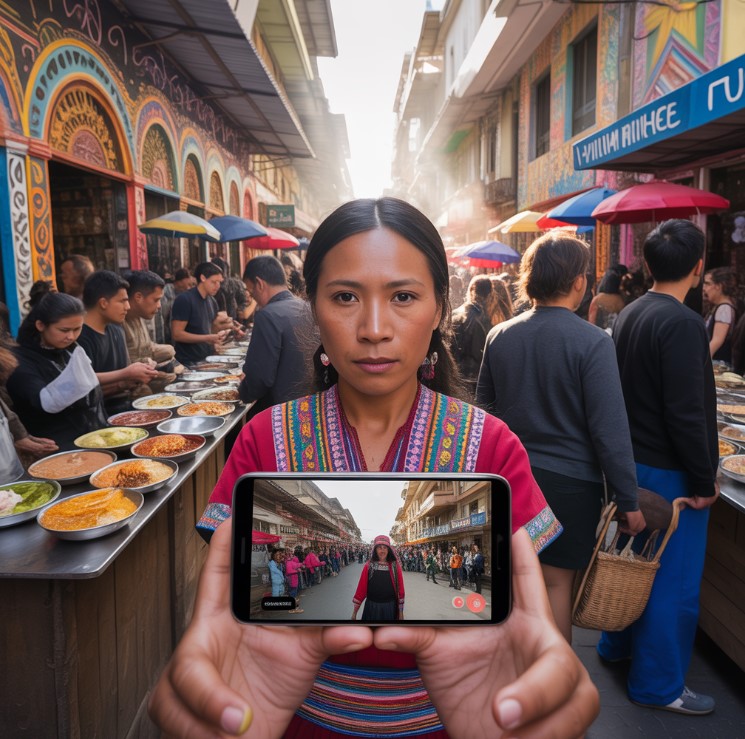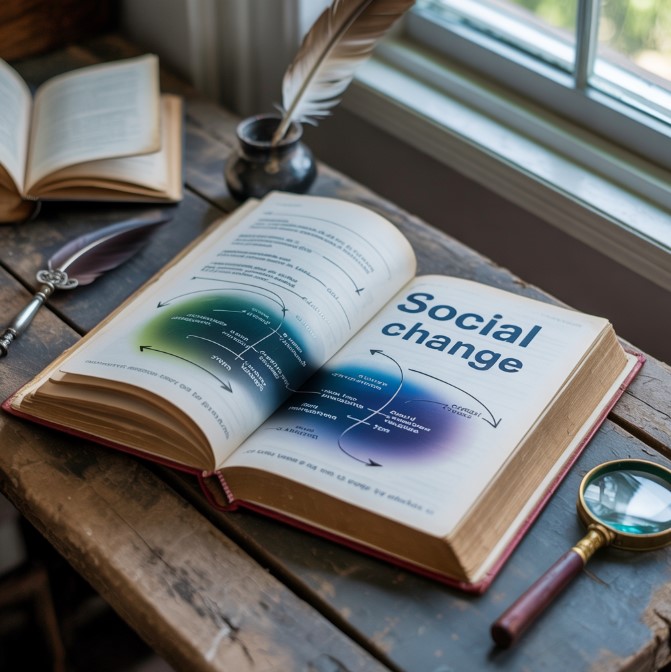Contents
The world today feels intrinsically linked. A vibrant mural in a distant city might blend indigenous motifs with contemporary street art, reflecting a global artistic dialogue. A dish once confined to a specific region now graces tables across continents, its flavors adapted yet recognizable. A social movement sparked online can sweep across borders instantaneously, mobilizing diverse populations for a common cause. These everyday experiences transcend mere economic transactions; they illustrate the profound cultural mixing and global interconnection reshaping our lives.
Globalization, while frequently discussed through an economic lens, is fundamentally a socio-cultural phenomenon. This pervasive process redefines human relationships, transforms individual and collective identities, and profoundly impacts creative expression worldwide. It is a powerful force that reshapes how societies interact and perceive themselves. This article will explore globalization not merely as a process of trade or capital flow, but as a complex transformation of shared meanings, identities, and the very fabric of societies, requiring a critical and nuanced understanding. This perspective, rooted in the social sciences and humanistic inquiry, offers a vital counterpoint to purely material analyses, reflecting a deep engagement with the human condition in a globalized era.
Deconstructing Globalization: Definitions from a Social & Humanistic Perspective
Understanding globalization requires a broad perspective beyond simplistic economic definitions. Globalization is the intensification of social relations across world-space, linking distant localities in such a way that local happenings are shaped by events occurring many miles away and vice versa. This definition emphasizes the cross-border flows of ideas, values, and practices, highlighting the increasing interconnectedness of human experiences globally. It moves beyond the movement of goods or capital to encompass the circulation of people, images, and cultural narratives.
Key concepts help illuminate this complex process. “Time-space compression” describes how advances in communication and transportation technologies effectively shrink the world, making distant places feel closer and interactions more immediate. “Deterritorialization of culture” refers to the weakening ties between culture and specific geographic territories, as cultural forms and identities become more fluid and less bound by national borders. “Global consciousness” signifies an increased awareness of the world as a single place, fostering a sense of shared destiny and responsibility among individuals. These theoretical frameworks provide essential tools for analyzing globalization’s profound impact on human societies. They offer a nuanced approach, acknowledging that purely economic definitions, often presented in business contexts, are insufficient to capture globalization’s full human impact. A comprehensive understanding of globalization demands an exploration of its social, cultural, and philosophical dimensions.
Historical Echoes of Global Interconnection: From Ancient Roots to Modern Accelerations
Globalization’s narrative extends far beyond the 19th-century industrial revolution. Globalization has deep historical roots in cultural exchange, not merely in trade. “Archaic” and “proto-globalization” periods offer compelling evidence of migrating ideas, artistic forms, and belief systems. The ancient Silk Road, for instance, functioned as a vital conduit for art and religion, not solely for goods. Buddhism traversed vast distances along these routes, transforming local cultures as it spread. Similarly, architectural styles and philosophical concepts diffused across empires, demonstrating early forms of cultural interconnectedness.
Several turning points in human history dramatically accelerated communication, migration, and cultural encounters. The Age of Exploration, beginning in the 15th century, profoundly impacted indigenous cultures globally, introducing new languages, religions, and social structures, often through coercive means. The post-World War II era saw a surge in media dissemination, with radio, television, and film facilitating unprecedented cultural flows. The digital revolution, commencing in the late 20th century, propelled cultural exchange into an entirely new dimension. These accelerations changed how people interact and perceive their place in the world, rather than just economic data points. People experienced shrinking distances and a growing awareness of global events, leading to a profound shift in their cognitive maps of the world. As cultural theorist Arjun Appadurai posits, “The new global cultural economy has to be understood as a complex, overlapping, disjunctive order.” This historical perspective underscores that cultural globalization is a long-standing process, albeit one that has dramatically intensified in recent times.
The Multiform Manifestations of Cultural Globalization Today
The contemporary landscape of cultural globalization is characterized by a fascinating interplay of converging and diverging forces. It is not a monolithic process but a dynamic, multifaceted phenomenon.
A. Cultural Homogenization and the “Supra-Culture”
One prominent manifestation of cultural globalization is the perceived spread of dominant cultural forms. This process, often termed “cultural homogenization,” describes the potential erosion of local distinctiveness. Global fast-food chains, for example, offer standardized menus across diverse continents, leading to similar culinary experiences. Hollywood films and popular music genres achieve worldwide reach, shaping aesthetic preferences and entertainment consumption globally. A study by the Pew Research Center in 2021 indicated that a significant percentage of young people in various countries consume content from global streaming platforms, often leading to shared cultural touchstones across borders. In the visual arts, global trends often influence local production. An emerging artist in Caracas might be inspired by contemporary art movements originating in New York or Berlin, potentially leading to stylistic similarities across different regions. This phenomenon can raise concerns about the loss of unique cultural expressions, as local traditions sometimes struggle to compete with globally disseminated products. As one social media user commented, “Every city looks the same now, with the same stores and music playing everywhere. Where’s the local flavor?” This sentiment captures the anxiety surrounding cultural standardization.
B. Cultural Hybridization and Emergent Forms
Countering the narrative of pure homogenization, cultural hybridization highlights the creative blending and fusion of cultures. This dynamic process generates entirely new cultural forms. Consider the rise of new music genres, like “Afrobeats” or “K-Pop,” which ingeniously combine local musical traditions with global pop elements, gaining immense international popularity. Culinary fusions, such as Peruvian-Japanese Nikkei cuisine or Tex-Mex, demonstrate how diverse food traditions can merge to create innovative and delicious new dishes. Multilingual literature often features characters who navigate multiple cultural identities, reflecting the complex realities of a globalized world. Global art movements, like street art or digital art, frequently incorporate local narratives and symbols into universally accessible forms, demonstrating a rich cross-cultural dialogue. These emergent forms arise from cross-cultural dialogue and adaptation, proving that globalization is not just about absorption but also about innovation. Fanny Pirela Sojo, in her work with “Communication and Cultural Creation,” has observed how local artists, far from being overwhelmed, actively appropriate and transform global influences into uniquely resonant expressions. “Our work at the Sala Mendoza often showcased how artists engaged with global themes, yet filtered them through a distinct Venezuelan sensibility,” she noted in a recent interview. This process demonstrates cultural resilience and dynamism.
C. The Digital Nexus: Reshaping Cultural Exchange
The internet and social media platforms have emerged as critical drivers of contemporary cultural globalization. These digital tools enable decentralized cultural production, allowing individuals and small groups to create and disseminate content globally without traditional gatekeepers. Instant information sharing facilitates the rapid spread of ideas, trends, and artistic expressions, fostering the formation of virtual global communities around shared interests, from niche art movements to environmental activism. Online platforms democratize cultural access, making previously exclusive or geographically distant cultural products available to a global audience. For example, a rare academic paper or an obscure musical genre from a remote region can now find a worldwide audience with ease. However, this digital ubiquity also presents challenges. The proliferation of misinformation and the persistence of digital divides, where access to technology remains unevenly distributed, pose significant obstacles to equitable cultural exchange. A recent study by the United Nations found that while global internet penetration is rising, billions still lack reliable access, exacerbating existing inequalities in cultural participation. This highlights the double-edged sword of digital globalization.
D. Political Dimensions of Cultural Flows
International organizations, cultural policies, and diplomatic efforts significantly influence the direction and nature of cultural globalization. Institutions such as UNESCO play a vital role in promoting and protecting cultural heritage globally, advocating for the recognition and preservation of diverse traditions. Bilateral cultural exchange programs facilitate direct interactions between artists, scholars, and citizens, fostering mutual understanding. Conversely, the absence of robust cultural policies or the imposition of cultural protectionist measures can limit cultural flows. Geopolitical power dynamics often shape the direction of cultural influence; nations with greater economic or political sway can more easily project their cultural products globally. An original opinion suggests that cultural diplomacy, when authentically practiced, can build bridges and mitigate conflicts by highlighting shared human values. As a research advisor for academic and institutional projects, understanding these political dimensions is crucial for effective cultural initiatives. Cultural flows are never purely spontaneous; they are often shaped by deliberate actions and policy frameworks at various levels of governance.
Critiques and Complexities: Navigating the Ethical Terrain of Global Culture
Globalization’s immense benefits are often accompanied by significant ethical and practical challenges, particularly concerning culture and identity. A critical perspective is essential for navigating this complex terrain.
A. The Challenge of Cultural Loss and Identity
A profound concern stemming from cultural globalization is the potential disappearance of unique languages, traditions, and local industries. Minority languages, for instance, face increasing pressure from dominant global languages, leading to a documented decline in linguistic diversity worldwide. The encroachment of globalized production methods can undermine traditional crafts and local economies, causing skilled artisans to lose their livelihoods. This leads to a loss of invaluable cultural heritage embedded in these practices. The psychological and social impact of perceived cultural dilution can be severe. Communities may experience a sense of alienation or a loss of collective identity as their distinct cultural markers fade. A recent report by the Endangered Language Project highlights that one language dies every two weeks, directly correlating with increased global interaction and dominance of lingua francas. This trend represents an irreversible loss of human knowledge and cultural diversity. Such a scenario underscores the urgency of proactive measures to preserve and revitalize vulnerable cultures.
B. Power Asymmetries and Inequality in Cultural Production
Cultural exchange within globalization is rarely equal; power asymmetries and inequalities frequently dictate who benefits and who loses. The commercialization of culture, for instance, often sees dominant cultural industries appropriate and monetize forms from marginalized communities without equitable compensation or recognition. This raises critical issues of intellectual property and fair trade in cultural goods. Major multinational corporations often dominate global media and entertainment industries, making it difficult for independent or local producers to compete for audience share. This dominance can lead to a monoculture of ideas and narratives, suppressing alternative voices. The debate over cultural appropriation versus appreciation is central here. Appropriation involves taking elements from another culture, often from a subordinate group, without understanding or respecting their original context, and frequently for commercial gain. Appreciation, conversely, involves a respectful engagement with and learning from other cultures. As a leading scholar in “Latin American Literature,” Fanny Pirela Sojo emphasizes how many literary works from the region grapple with these very dynamics, exploring colonial legacies and contemporary power imbalances in cultural representation. “Our intellectual discourse must continually interrogate who speaks, for whom, and under what conditions,” she often reiterates in her lectures.
C. The Role of Education and Artistic Practice
Education and artistic practice play a crucial role in either perpetuating or challenging these complexities. Education, in its broadest sense, can be a powerful tool for fostering critical cultural literacy. By teaching students to analyze media, understand diverse cultural perspectives, and identify power imbalances in cultural representations, educational institutions can equip them to navigate a globalized world thoughtfully. My own experience as an “educator” and “education coordinator” has reinforced the importance of curricula that promote intercultural dialogue and empathy. We aimed to cultivate in students not just knowledge, but a critical consciousness about global cultural flows. Artistic practice, similarly, offers a vital space for both reflection and resistance. Artists can use their work to challenge dominant narratives, preserve endangered traditions, and create new forms that celebrate cultural hybridity. Contemporary thought encourages us to see art not just as a product but as a process of cultural negotiation. For example, indigenous artists using digital media to tell their ancestral stories exemplify how art can both embrace new technologies and strengthen cultural identity. As a participant in “contemporary thought” discussions, I believe that conscious pedagogical and artistic interventions are essential for shaping a more equitable and diverse global cultural future. An educational program could focus on “media literacy,” teaching young people to critically evaluate information from global sources, distinguishing between authentic cultural expressions and commercialized imitations. This proactive approach ensures that individuals become active participants, not just passive recipients, of global culture.
Conclusion: Cultivating a Responsible and Rich Global Future
Globalization, particularly in its cultural forms, is a powerful, multifaceted, and irreversible process. It has brought unprecedented interconnectedness, enriching lives through exposure to diverse ideas, traditions, and artistic expressions. It has fostered a global consciousness, reminding humanity of its shared challenges and common heritage. Yet, this intricate process also presents significant ethical and practical challenges, including the risk of cultural loss, the persistence of power asymmetries, and the exacerbation of inequalities in cultural production. A critical understanding, informed by disciplines like philosophy, social sciences, and cultural studies, is paramount.
Shaping globalization’s future requires conscious, ethical, and sustained effort from individuals, institutions, and governments. We must prioritize promoting cultural diversity and heritage, actively working to preserve unique languages, traditions, and art forms from around the world. Fostering genuine cross-cultural understanding and empathy through education and exchange programs remains a vital endeavor. This includes encouraging respectful engagement with other cultures and moving beyond superficial appreciation. Supporting independent and local artistic and cultural initiatives is also crucial; these often represent the authentic voice of a community and provide alternatives to globally dominant cultural products. The ongoing role of critical inquiry and education in navigating these complexities cannot be overstated. By teaching future generations to analyze, question, and engage thoughtfully with global cultural flows, we empower them to become responsible global citizens. Critical thinking skills are essential for distinguishing between cultural exchange and cultural exploitation. Ultimately, this reflective statement concludes that human capacity can create a globalized world that truly celebrates, rather than diminishes, its diverse cultural expressions. A future where global interconnectedness leads to a richer, more vibrant cultural tapestry for all is within our reach, demanding our continuous dedication and collaborative action.




